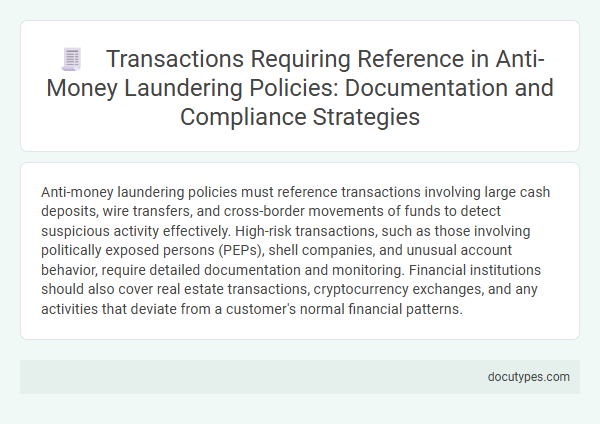Anti-money laundering policies must reference transactions involving large cash deposits, wire transfers, and cross-border movements of funds to detect suspicious activity effectively. High-risk transactions, such as those involving politically exposed persons (PEPs), shell companies, and unusual account behavior, require detailed documentation and monitoring. Financial institutions should also cover real estate transactions, cryptocurrency exchanges, and any activities that deviate from a customer's normal financial patterns.
Introduction to Transaction References in AML Policies
| Introduction to Transaction References in Anti-Money Laundering (AML) Policies | |
|---|---|
| Definition | Transaction references in AML policies are unique identifiers or detailed descriptions linked to financial transactions. They enable traceability and monitoring for suspicious or illicit activities. |
| Purpose | References serve to ensure transparency, facilitate audit trails, and support regulatory compliance in identifying money laundering attempts. |
| Types of Transactions to Reference |
|
| Regulatory Frameworks | AML policies align with standards set by the Financial Action Task Force (FATF), local regulatory authorities, and international banking regulations requiring comprehensive transaction referencing. |
| Key Benefits | Enhanced detection of laundering schemes, easier investigation processes, and stronger defense against financial crime risks. |
Regulatory Framework for AML Transaction Documentation
What types of transactions must be referenced in anti-money laundering policies? Regulatory frameworks for AML transaction documentation require the inclusion of all significant financial transactions, especially those involving large sums, cross-border transfers, and unusual patterns that may indicate suspicious activity. Ensuring your AML policy references these transactions helps maintain compliance with legal standards and enhances financial transparency.
Types of Transactions Requiring Reference in AML Programs
Anti-money laundering (AML) policies must reference specific types of transactions to effectively detect and prevent illicit financial activities. Identifying these transactions helps strengthen your compliance framework and reduces the risk of financial crime.
- Large Cash Transactions - These involve cash deposits or withdrawals exceeding regulatory thresholds that warrant reporting and monitoring.
- International Wire Transfers - Cross-border electronic funds transfers require scrutiny due to their potential use in moving illicit money.
- Suspicious Activity Transactions - Transactions that appear unusual or inconsistent with a customer's profile must be referenced and investigated.
Key Documentation Required for High-Risk Transactions
Anti-money laundering policies must reference transactions involving large cash deposits, international wire transfers, and suspicious activity reports. Key documentation required for high-risk transactions includes customer identification records, detailed transaction descriptions, and proof of the source of funds. Maintaining comprehensive records ensures compliance with regulatory standards and aids in detecting illicit financial activities.
Reference Procedures for Large and Unusual Transactions
Anti-money laundering policies require referencing transactions that are large, unusual, or suspicious to ensure compliance and detect potential illicit activities. Large transactions typically include cash deposits or withdrawals exceeding predetermined thresholds, while unusual transactions deviate from normal patterns without clear economic rationale. Your reference procedures must document these transactions promptly, enabling thorough review and reporting in alignment with regulatory standards.
Record-Keeping Standards in AML Compliance
Anti-money laundering (AML) policies require strict referencing of various types of transactions to ensure effective detection and prevention of illicit activities. Accurate record-keeping is essential to maintain transparency and compliance with regulatory standards in financial institutions.
- Cash Transactions - All cash deposits, withdrawals, and exchanges exceeding the regulatory threshold must be documented to track suspicious activities.
- Wire Transfers - Incoming and outgoing wire transfers require detailed records including origin, destination, and purpose to comply with AML regulations.
- Suspicious Transactions - Any transaction flagged for irregularity or potential money laundering must be meticulously recorded and reported according to AML policy guidelines.
Maintaining comprehensive transaction records supports effective audits and regulatory reviews, reinforcing AML compliance frameworks.
Use of Technology for Transaction Reference Tracking
Anti-money laundering (AML) policies require referencing high-value financial transactions, suspicious activities, and cross-border transfers to ensure comprehensive monitoring and compliance. Technology plays a crucial role in accurately tracking and referencing these transactions to prevent illegal fund flows.
Use of technology in AML policies enables automated transaction reference tracking through advanced algorithms and machine learning, enhancing detection accuracy. Blockchain and AI systems provide immutable records and real-time analysis, helping institutions quickly identify suspicious patterns. These technological tools streamline regulatory reporting and improve overall transparency in financial operations.
Common Pitfalls in AML Transaction Documentation
Anti-Money Laundering (AML) policies must reference all transactions involving large cash deposits, wire transfers, and suspicious activity reports. These transaction types are critical to identify potential money laundering schemes and ensure compliance with regulatory standards.
Common pitfalls in AML transaction documentation include incomplete records and failure to link transactions to verified customer identities. Your policy should enforce thorough documentation to avoid gaps that could undermine investigations or audits.
Auditing and Review of Transaction References
Anti-Money Laundering (AML) policies must clearly specify the types of transactions that require referencing to ensure thorough auditing and review. Proper documentation and referencing of these transactions facilitate effective detection and prevention of illicit financial activities.
- High-Value Transactions - Transactions exceeding a predefined monetary threshold must be referenced for detailed auditing to identify unusual patterns.
- Suspicious Transactions - Any transaction flagged as suspicious based on behavior, amount, or origin requires comprehensive documentation and review.
- Cross-Border Transfers - Transactions involving international transfers must be referenced to comply with global AML standards and facilitate traceability during audits.
What Types of Transactions Must Be Referenced in Anti-Money Laundering Policies? Infographic

